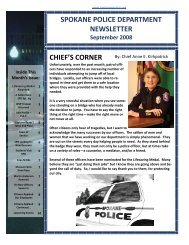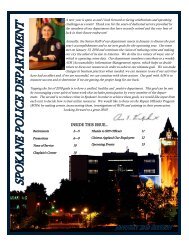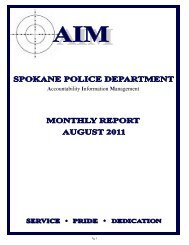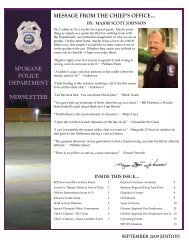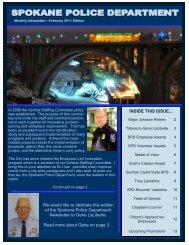DRAFT REPORT OF THE CITY OF SPOKANE USE ... - Samuel Walker
DRAFT REPORT OF THE CITY OF SPOKANE USE ... - Samuel Walker
DRAFT REPORT OF THE CITY OF SPOKANE USE ... - Samuel Walker
You also want an ePaper? Increase the reach of your titles
YUMPU automatically turns print PDFs into web optimized ePapers that Google loves.
City of Spokane Use of Force Commission December 20, 2012<br />
civilian or internal complaints, civil suits, or criminal charges against an officer for<br />
matters other than the use of force.<br />
It is important to make sure that EIS thresholds are set at an appropriate level so as to<br />
initiate relevant and effective intervention (i.e., not so high that intervention never occurs<br />
or occurs too late). For example, recognizing that the officers who are of particular<br />
concern are indeed the outliers on the force, thresholds for triggering intervention can<br />
be set to capture approximately 3-5% of the line officer population. Additionally, the<br />
criteria for the system should take into account the need to create single-event<br />
thresholds for occurrences that are so critical that they require immediate department<br />
intervention and should implement rolling thresholds, thereby ensuring that an officer<br />
who has received an intervention is not permitted to engage in the initial threshold<br />
number of additional events before again triggering the EIS. Finally, the structure of the<br />
system must ensure that interventions follow close in time to the actual triggering event.<br />
Once the EIS is triggered for an officer, it is critical that the supervisor conduct a<br />
thorough review, take appropriate action, and be diligent in tracking resolution. The<br />
supervisor should review any triggering event in its entirety and prescribe appropriate<br />
resolutions or training opportunities specifically targeted to the behavior that prompted<br />
the intervention. At a minimum, supervisors should be required to review the EIS files<br />
on each subordinate every two months and a response by a supervisor should be<br />
required within two weeks of detecting a red flag. Thereafter, the supervisor should<br />
check the EIS on that officer every month for twelve months to determine if the<br />
response has satisfactorily resolved the issue. In each instance of a red flag, the<br />
supervisor should document what action was taken and document the event in at least<br />
the subject officer’s next performance evaluation and the officer’s next promotion<br />
recommendation. Ideally, a regular audit of the system would be conducted to make<br />
sure that it is being optimally deployed.<br />
Recommendation #18 – Equip officers with body cameras.<br />
Providing officers with body cameras will preserve important evidence of the<br />
circumstances surrounding encounters between the SPD and citizens. Although no<br />
recording can be a perfect record of the totality of an event, body cameras will help SPD<br />
officers gather evidence, improve the quality of their reports, and protect them from<br />
false citizen complaints, and they will provide valuable evidence when the<br />
circumstances of an encounter are called into question by any source.<br />
Recommendation #19 – Explore standardizing the weapons carried by officers in<br />
the line of duty.<br />
The Commission is aware that there is variation in the types of weapons that SPD<br />
officers are allowed to carry. For example, officers are allowed, with permission, to<br />
carry non-standard firearms or batons. While some have expressed a concern about<br />
this practice, the Commission is not in a position to state that it should be continued or<br />
disbanded. Rather, the Commission recommends that the Chief of Police review the<br />
City of Spokane Use of Force Commission – Page 24






